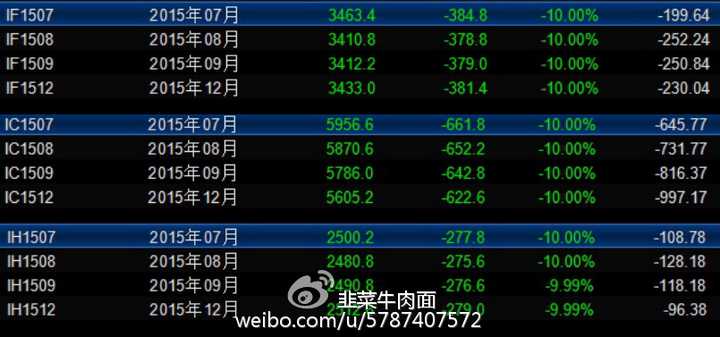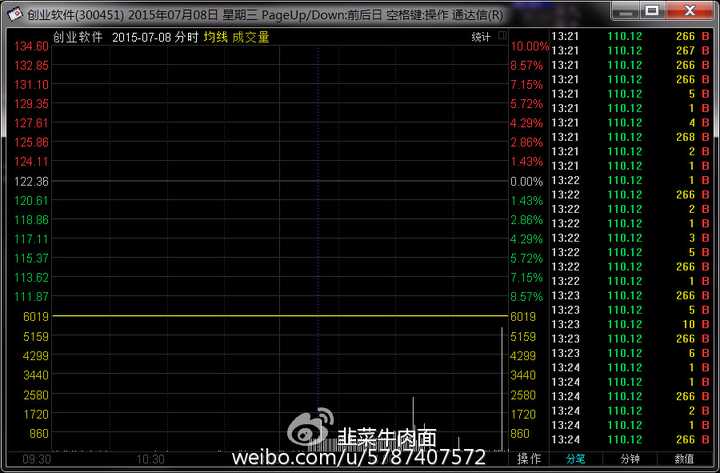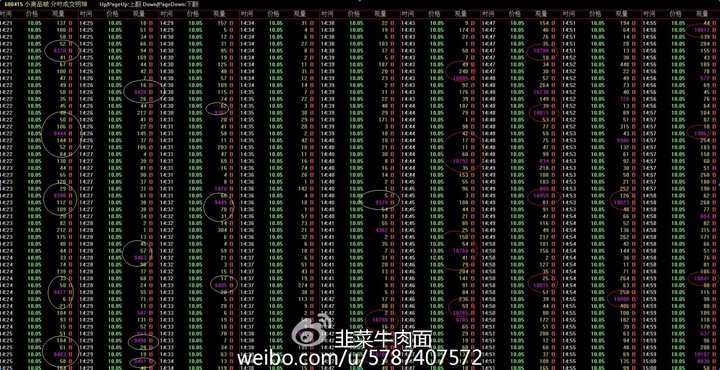许多年后回望2015年的股灾,后来人对它最大的两个印象将是“杠杆”和“千股跌停+千股停牌+千股涨停”。人脑的自我保护机制发挥着作用,或许很多亲历者的感受也将只剩下关键词,没人想拥有这种罕见的悲剧回忆。除了每天账户跌停想跑都不让跑,对于无数强平爆仓者来说,甚至账户里有东西还能跌停一下都是奢望。我本人写此文时,许多地方亦是只记得框架,诸多细节已然渐渐模糊,这使我越发觉得应完整记录下股灾前前后后的记忆,此为一。
当局者迷?不全是如此。知乎股票区当前最高票答案有这么一句话写得不错:“如果在A股市场上你看见了一支股票在日线或者周线级别出现MACD顶背离的时候,那么请你立刻Run! Run! Run!跑,快跑!不论你买入价位是多少,目前有没有盈利。先跑出去再看,不要有任何心存侥幸和留恋。”但当6月16日上证指数出现日线MACD顶背离的时候,答案的作者却没有这么做。这里绝不是指责他。身处历史的进程中,在纷乱的信息里,谁知道哪根才是值得大书特书的压垮骆驼的最后一根稻草?后人对着走出来的K线图看,顶部的风险总是巨大的,离场提示总是明显的,他们总是会问,为什么当初的人们毫无察觉呢?
对量化交易有研究的人都知道,这是典型的“未来信息”问题。所谓未来信息,就比如说,你在选择回测标的的时候去掉了那些出现过黑天鹅的个股,那你的结果当然好于实盘,但这样一来将导致你错误地评估这个策略,因为在当时你是无法知道这个个股会不会出现黑天鹅的。所以,当我们反思股灾的时候,就要在获得未来信息后再去掉它,才能真正反思到当初犯错误的深层原因。如今一周年过去,就是这么做的绝好契机,此为二。
同时,为力求严谨,特别为了对得起多年后再读本文的读者,我花了相当的精力去一一查证文中的回忆,以免错漏。举个小例子:千股停牌,是不是夸张的说法?停牌最多的时候,看当日的报道,有说1000家,有说1400家,还有说1200家的,还都说自己援引了wind或者巨潮资讯网的数据。虽然这个数据没有重要到要精确到停牌具体家数,但我还是自己写了个公式(不准确会漏)去筛当初的数据再查证一遍,就为了告诉读者这么一件事:说起来你可能不信,还真是“千股”停牌。做了这些微小的工作,希望下一轮牛市,甚至十年二十年后的人们读来,亦能切身体会当时的情境。
下面,首先是不开上帝视角的版本,建议阅读时打开K线图,遮掉后面的走势,以当时的视角,当时的同样的权重解读各条信息,万一是我故意加进来干扰你的呢?
1月13日至16日,中信证券连续减持股票34813.17万股,占公司总股本的3.16%,合计减持套现资金超过100亿元。(1)
1月16日盘后(2),证监会通报:对券商两融业务现场检查结束,并对违规券商采取严格的行政监管措施。严查两融不仅直接打击了市场人气板块券商股,更是对控制杠杆这一意图的表示。下一交易日1月19,上证指数跳空低开-5.53%,以-7.70%报收。
3月25日,顶着“投机”、“炒作”、“泡沫”、“市梦率”、“博傻”的声音和简陋总部与高股价不相称的质疑,全通教育股价摸高至348元。
3月26日,全通教育跌停,把多头教育了一遍。
4月7日,南北车复牌。此前的官方辟谣重组和停牌前南北车高管互买对方股票这都不算事,毫无疑问的缩量一字板。
4月16日,中国证监会主席助理张育军出席证券公司融资融券业务情况通报会,并对证券公司开展融资融券业务提出了七项要求,不得以任何形式参与场外股票配资、伞形信托等活动,不得为场外股票配资、伞形信托提供数据端口等服务或便利。
一月查两融后指数很快收复失地,于三月份突破前高。四月份再次通报规范两融时,市场已无过大反应。(3)
4月21日,人民日报发表著名文章《4000点才是A股牛市的开端》。
假期归来,风云突变。5月4日上证指数日线MACD顶背离。5月5日、6日、7日,由于打新冻结大量资金,上证指数出现了牛市中极罕见的连续三根大阴线。同样,这次也很快收复失地创出新高。(4)
5月13日,全通教育再度大涨至467.57元,并以涨停价报收,把空头也教育了一遍。
5月13日,朗玛信息最高价474元,超越全通教育。
5月13日,中国核电首发申请通过审核,拟募集资金162.5亿元。
有报道指:2007年10月超级大盘股中国石油IPO,当月大盘见顶6124点;2009年7月中国建筑IPO,随后大盘见顶3478点。
5月25日乐视网公告,贾跃亭拟减持公司股份总数8%的股票。当日收盘价76.31(复权),是半年前低点12.77(复权)的六倍。市场估计贾此次套现约100亿元(5),数据显示,该月以来,125家其他创业板公司重要股东的总减持金额也不过133亿元。
5月28日消息,港交所披露的公开资料显示,中央汇金于5月26日在A股场内减持工行和建行,金额分别为16.29亿和19.06亿元。同日上证指数暴跌6.50%。
6月3日,国泰君安上市过会,募集资金300亿元,单只新股冻结资金超过3万亿元。
6月8日,合并后的中国中车A股复牌后再度一字涨停,市值8841.56亿元(约合1425亿美元)。H股涨4.53%,市值4278.88亿港元(约合552亿美元)。中车A+H股市值达1977亿美元,超过波音+空客市值。
6月9日,一带一路+国企改革+高端制造三大主线板块的龙头中国中车近涨停开盘,5分钟内股价跳水至跌停。后又反弹,但最终跌停附近报收。
6月10日,ID为“想挣钱的散户”在股吧发帖,称自己融资四倍全仓中车,爆仓了愿赌服输,跳楼自杀。此前4月16日,ID“赵老哥”也曾在淘股吧发帖《八年一万倍》:“今天是值得纪念的一天,资金终于上了一个大台阶,感谢中国神车!!!”(6)
6月12日星期五,上证指数创出5178点新高(7)。证监会发布了《关于加强证券公司信息系统外部接入管理的通知》,但这并不影响投资者又度过一个愉快的周末。
6月23日,5178后仅第五个交易日,上证指数出现4264的低点,低点相比最高价跌去18%,留下两个跳空缺口。但市场随后开始反弹。
对于成熟的杠杆投资者而言,破位止损是最简单的一件事,因为不学会截断亏损的人是活不下来的。对于不成熟的杠杆投资者,止损又是最难的一件事:市场算个什么玩意,害我亏一倍就算了,凭什么我的本金还要加倍亏?
但此时不成熟的高杠杆投资者已然远远多于前者。
6月25日,上证指数的反弹受阻于拐头向下的20日成本均线。
6月26日,指数以一个漂亮的向下跳空宣告了成本均线压制成功。牛死了。右侧资金开始抢跑道。
杠杆资金一旦跌幅达到平仓线,就会强制平仓,不计成本抛售。如果杠杆资金像一个正的金字塔,那强平不会有多大影响,但如果这个金字塔上下一样宽,甚至变成了倒金字塔,那就会出现可怕的连环强平。1:10的资金强平往下砸,带动股票进一步下跌……然后触发1:6的强平,再轮到1:5的强平……
在这种情况下,一旦跌幅达到成本线下方某个点,就意味着碰倒了第一张多米诺骨牌。(8)于是出现了更糟糕的情况:不仅是右侧资金,杠杆资金也开始抢跑道。抢跑道的结果就是:创业板暴跌9%。
6月26日下午,张晓军在证监会例行发布会上对市场关切的问题回应道:这是市场前期过快上涨的自然调整。(9)
6月27日,央行降息+降准,央视良心字幕组在新闻下方提示:一旦逃出火场后,不要再返回火场。这是字幕组超神之路上漂亮的first blood。
6月29日,-5%到+5.53%,这TM是上证指数?
其余时间就是密集的大大小小的利好,然而在下跌趋势面前这并没有什么卵用,还是天天跌停。
7月4日5日周末,李克强总理回国主持救市,其中最重要的三条利好是:1、21家证券公司出资不低于1200亿元投资蓝筹股ETF。2、IPO暂停,交了的申购款也都退回。3、央行将协助通过多种形式给予中国证券金融股份有限公司流动性支持,讲白了就是信用卡无限刷。
7月6日,重磅利好下上证指数高开7.82%。大批散户倾其所有杀入股市,11点到了,传闻中的1200亿成功出逃,摆在证监会面前:老大,1200亿到位了……抄底高手们惊讶地问:“说好的各路资金呢?”答:“你不就是各路资金吗?”啊当然了本条后两句是段子。
7月7日8日,千股停牌避险,数量之多在中国证券史上前所未有。(10)
7月7日11点左右,创业板跌到-5.69%,在没有熔断的情况下,剩下时间走势几乎呈一条直线。也就是说,除停牌股外,整个板块跌停了。
7月8日,沪深300、中证500、上证50三大股指期货共计12大主力合约全线跌停。 7月7日8日,国家队在多只个股的跌停板脉冲式吃货,测试抛压,带动人气。以创业软件为例,一发子弹266手,人民币300万在跌停板点射。
7月7日8日,国家队在多只个股的跌停板脉冲式吃货,测试抛压,带动人气。以创业软件为例,一发子弹266手,人民币300万在跌停板点射。 点射频率越来越快变成扫射。各种利好无效,满屏皆绿之下,这是绝境中人们的最后一丝希望,股吧有人激动发帖“266哥快加油啊”。可266哥似乎没有看到,很快扫射停了,跌停板撤掉的单涌了上来。14:56,国家队一笔吃掉跌停板上所有封单,似乎希望来了。但没有用,集合竞价时跌停板马上又被封死。
点射频率越来越快变成扫射。各种利好无效,满屏皆绿之下,这是绝境中人们的最后一丝希望,股吧有人激动发帖“266哥快加油啊”。可266哥似乎没有看到,很快扫射停了,跌停板撤掉的单涌了上来。14:56,国家队一笔吃掉跌停板上所有封单,似乎希望来了。但没有用,集合竞价时跌停板马上又被封死。 分时成交明细图不好找,引用了@徐怀川在小商品城(600415)上的一张截图。但打开交易软件的历史回忆,你仍然可以看到,那一天的夕阳下,那一天的跌停上,那一排的成交量,整齐得像一排刚割过的韭菜。
分时成交明细图不好找,引用了@徐怀川在小商品城(600415)上的一张截图。但打开交易软件的历史回忆,你仍然可以看到,那一天的夕阳下,那一天的跌停上,那一排的成交量,整齐得像一排刚割过的韭菜。
7月9日上午,公安部副部长孟庆丰带队到证监会排查近期恶意卖空股票与股指的线索。
几日来的果断救市,国家队掏出真金白银将可能引发系统性金融风险的大量高杠杆资产置换出来,同时为灾中自救提供了必要的流动性。连续快速的杀跌虽然引发了众多投资者爆仓清盘,但客观上也是风险的释放。7月9日,无数个股从跌停到涨停,终于迎来了胜利大反攻。
8月,国家队救市股陆续披露,资金扎堆炒作,史称“王的女人”概念。头牌梅妃,梅雁吉祥。
炒作过程中,市场自然注意到了美邦服饰(002269)在股灾中的异动。龙虎榜显示,7月6日,中信证券北京总部买入3亿,这是国家队的救市席位(11)。7月8日,中信证券的国家队席位再次大举买入29亿。但也有传言称国家队先救美邦服饰的原因是某高官被套,打电话让国家队来救。这使得市场开始反思国家队救市选股策略,巨额利益面前是否存在老鼠仓,内幕交易?
8月11日,811汇率改革,人民短时间内连续贬值。
由此,8月18日至8月26日,股灾的2.0版本来了。除了8月19日反抽确认的阳线外,短短7个交易日内留下六根大阴线和两个向下跳空缺口,上证指数自3999点跌至2850点。前期救市低点3373和3000点整数关口都被瞬间击穿,毫无抵抗。
相比1.0,股灾2.0暴跌频率更高,且国家队主战场在汇市无暇他顾,加之投资者刚扛过股灾迎来大反弹,正是心态最放松的时候,使得股灾2.0投资者的平均损失更超以往。
话说到这里,故事最精彩,也足以引发系统性金融风险的股灾1.0和股灾2.0,也要落下帷幕了。(12)
再后来,就是那些逐渐浮出水面的内幕交易(13):
8月25日,作为此前券商之首和头号救市主力的中信证券,被通报徐某等8高管涉嫌违法从事证券交易活动,被公安机关要求协助调查。
9月15日,在此前就有多名高管被查的情况下,中信证券总经理程博明因涉嫌内幕交易、泄露内幕信息被公安机关依法要求接受调查。
次日,程的同门师兄弟,曾担任“救市总指挥”的中国证监会主席助理张育军被查。巧合的是,有报道称张育军此前与基金经理开会时曾说,未来的犯罪分子就“坐在这房间中”。
11月1日,徐翔等人涉嫌通过非法手段获取股市内幕信息,从事内幕交易、操纵股票交易价格等被逮捕。
11月13日证监会副主席姚刚同样因为“涉嫌严重违纪”的原因接受组织调查。
至此,2015股灾大事件记录完毕。如今,不妨打开上帝视角, 再度梳理事件背后的逻辑:
对照(1)、(2)的时间不难发现,中信的减持恰好在官方通报之前。这叫“让领导先走”。
又何止是“让领导先走”?119大跌由强制去杠杆引发,后果是出现了近七年最大单日跌幅的暴跌,背后是中信敏感时刻精准减持。起因,后果,内幕,熟悉否?回头看才知道,这几乎是股灾1.0的预演,也是整个大股灾的缩影。
(3)和(4)的大利空创新高,是牛市给新韭菜的锚。6000高点必破和就算见顶了也会有双顶,会给个跑路的机会,是上轮牛市给老韭菜的锚。锚定效应之下,大家都别跑。
(5)事后看,贾跃亭也“仅”套现出57亿元——这个数字是2014全年归属母公司股东净利润的近16倍,是2015全年归属母公司股东净利润的近10倍。
(6)财富的转移,最典型的。这将是给做着不劳而获发财梦涌进下轮牛市的韭菜们上的课,也是对最肯努力的投资者的奖赏。
(7)事后看,这是本轮牛市的顶部。
(8)X日成本线下方某个位置将触发杠杆连环强平——这个位置在哪是股灾最为重要的数据,我命名它为“连环强平点”。当杠杆比例畸高的时候,它就出现了。位置可能在X日成本线下方5%、10%或者20%,由杠杆盘比例和杠杆盘换手率推算得出,其中X就是杠杆盘换手率的倒数。哪怕只有估计值,也相当于知道了多米诺骨牌的摆放方式、看到了对手的作战地图。这样一来,是取走几块以免一倒全倒,还是在最致命的地方用力一推,知道它的人就拥有了最大的选择权。这个数据,当时市场是不知道的。而单从技术层面来说,如果监管层想知道,是有办法获取到的。
(9)谁信谁傻逼。
(10)吃一堑长一智,这促使监管层进一步完善停复牌规则。千股停牌前无古人,或许也后无来者了。
(11)7月6日同时出现在买二的上海溧阳路买入5200万,卖出2200万,传这是私募一哥徐翔的席位。但在当时,谁又能注意到这天的龙虎榜藏着秘密?这就是内幕信息带来的极大信息不对称。
(12)当然,在这之后,还有四天四熔断的股灾3.0,那是2016年开年的事啦。
(13)这段内幕交易的来龙去脉,我想原文援引2016年6月21日腾讯财经的报道。“股灾发生之前,有上海官员家属追随徐翔买入美邦服饰,其中包括艾宝俊的亲属。”上述接近上海官场的知情人士透露,股灾发生时,她们被套牢,而后找到徐翔接盘,“徐翔跟她们关系匪浅,就用了泽熙之外的账户接盘,接盘后同样无法解套。徐翔此前已经跟中信证券建立联系,这就有了中信证券使用国家队资金拉高美邦服饰后,助徐翔出逃的故事。”
在即将结束本文的时候,再说一说(8)中提到的关键数据“连环强平点”,因为还它关系到另一个重要的话题:股灾的定性。关于股灾,去杠杆说者有之,那为什么这次去杠杆发生这么大的股灾了呢?阴谋论者有之,那事到如今“恶意大空头”抓到了吗,可有眉目?去泡沫去估值说者有之,那为什么是这个时候以这种方式去呢?
在我看来,以上因素皆有,杠杆是最直接原因,也是波动的放大器,使得这轮下跌速度之快,影响之深,称之为“灾”。那“内鬼”“恶意大空头”有没有呢?这取决于监管层是怎么利用“连环强平点”这个数据的,大致分三种可能:不重视所以不知道;知道后透露给某些人;不仅透露给某些人,还在关键时刻发布行政命令,或干扰舆论,推波助澜。救市中的故事已在金融反腐风暴中被揭开,那导致了无视投资者损失的股灾之前的故事呢?究竟是哪种可能,是否有人利用了这个数据达到了某些目的?我想,时间会给我们答案。
最后,立个小flag吧。牛市的末期,会有最后的疯狂和最不该的一次心存侥幸。2015年牛市如此,下一轮下下一轮牛市也会是如此。到了见顶牛转熊,管不住手的时刻,愿本文能帮到各位。
from:https://www.zhihu.com/question/47428421



 7月7日8日,国家队在多只个股的跌停板脉冲式吃货,测试抛压,带动人气。以创业软件为例,一发子弹266手,人民币300万在跌停板点射。
7月7日8日,国家队在多只个股的跌停板脉冲式吃货,测试抛压,带动人气。以创业软件为例,一发子弹266手,人民币300万在跌停板点射。 点射频率越来越快变成扫射。各种利好无效,满屏皆绿之下,这是绝境中人们的最后一丝希望,股吧有人激动发帖“266哥快加油啊”。可266哥似乎没有看到,很快扫射停了,跌停板撤掉的单涌了上来。14:56,国家队一笔吃掉跌停板上所有封单,似乎希望来了。但没有用,集合竞价时跌停板马上又被封死。
点射频率越来越快变成扫射。各种利好无效,满屏皆绿之下,这是绝境中人们的最后一丝希望,股吧有人激动发帖“266哥快加油啊”。可266哥似乎没有看到,很快扫射停了,跌停板撤掉的单涌了上来。14:56,国家队一笔吃掉跌停板上所有封单,似乎希望来了。但没有用,集合竞价时跌停板马上又被封死。 分时成交明细图不好找,引用了@徐怀川在小商品城(600415)上的一张截图。但打开交易软件的历史回忆,你仍然可以看到,那一天的夕阳下,那一天的跌停上,那一排的成交量,整齐得像一排刚割过的韭菜。
分时成交明细图不好找,引用了@徐怀川在小商品城(600415)上的一张截图。但打开交易软件的历史回忆,你仍然可以看到,那一天的夕阳下,那一天的跌停上,那一排的成交量,整齐得像一排刚割过的韭菜。




